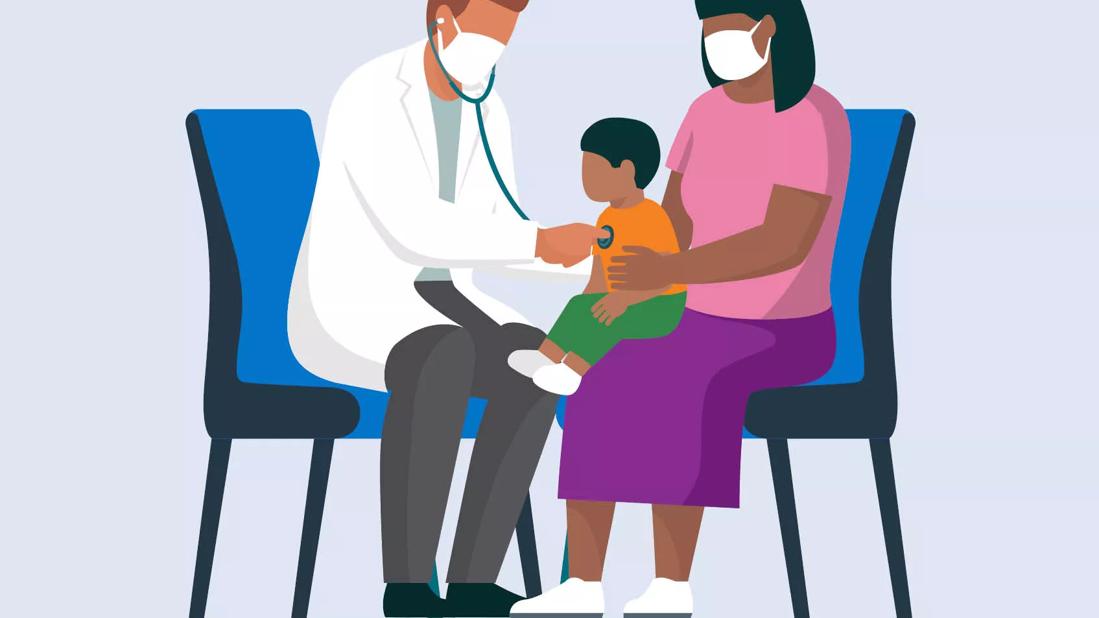Typically, you don’t need to monitor your child’s four vital signs

It’s like a parental reflex. Your child says, “I don’t feel good,” and your hand shoots out to feel their forehead. As a parent or caregiver, you’re always on the lookout for changes in your child’s health.
Advertisement
Cleveland Clinic is a non-profit academic medical center. Advertising on our site helps support our mission. We do not endorse non-Cleveland Clinic products or services. Policy
Temperature is one of your child’s vital signs you’ve probably measured at home. Pediatricians check it, too. The other vital signs are blood pressure, heart rate and respiration rate.
Each of these four vital signs gives info about your child’s basic body functions. Vital signs outside the normal range can point to an illness or health issue.
Pediatrician Amy Sniderman, MD, explains what these measurements mean and outlines normal pediatric vital signs for children of all ages.
| Age | Normal blood pressure range (mm Hg) | Normal heart rate (beats per minute) | Normal respiratory rate (breaths per minute) |
|---|---|---|---|
| 0 to 3 months | 65–85/45–55 | 110–160 | 30–60 |
| 3 to 6 months | 70–90/50–65 | 100–150 | 30–45 |
| 6 to 12 months | 80–100/55–65 | 90–130 | 25–40 |
| 1 to 3 years | 90–105/55–70 | 80–125 | 20–30 |
| 3 to 6 years | 95–110/60–75 | 70–115 | 20–25 |
| 6 to 12 years | 100–120/60–75 | 60–100 | 14–22 |
| 12 to 18 years | 100–120/70–80 | 60–100 | 12–18 |
| Age | |||
| 0 to 3 months | |||
| Normal blood pressure range (mm Hg) | |||
| 65–85/45–55 | |||
| Normal heart rate (beats per minute) | |||
| 110–160 | |||
| Normal respiratory rate (breaths per minute) | |||
| 30–60 | |||
| 3 to 6 months | |||
| Normal blood pressure range (mm Hg) | |||
| 70–90/50–65 | |||
| Normal heart rate (beats per minute) | |||
| 100–150 | |||
| Normal respiratory rate (breaths per minute) | |||
| 30–45 | |||
| 6 to 12 months | |||
| Normal blood pressure range (mm Hg) | |||
| 80–100/55–65 | |||
| Normal heart rate (beats per minute) | |||
| 90–130 | |||
| Normal respiratory rate (breaths per minute) | |||
| 25–40 | |||
| 1 to 3 years | |||
| Normal blood pressure range (mm Hg) | |||
| 90–105/55–70 | |||
| Normal heart rate (beats per minute) | |||
| 80–125 | |||
| Normal respiratory rate (breaths per minute) | |||
| 20–30 | |||
| 3 to 6 years | |||
| Normal blood pressure range (mm Hg) | |||
| 95–110/60–75 | |||
| Normal heart rate (beats per minute) | |||
| 70–115 | |||
| Normal respiratory rate (breaths per minute) | |||
| 20–25 | |||
| 6 to 12 years | |||
| Normal blood pressure range (mm Hg) | |||
| 100–120/60–75 | |||
| Normal heart rate (beats per minute) | |||
| 60–100 | |||
| Normal respiratory rate (breaths per minute) | |||
| 14–22 | |||
| 12 to 18 years | |||
| Normal blood pressure range (mm Hg) | |||
| 100–120/70–80 | |||
| Normal heart rate (beats per minute) | |||
| 60–100 | |||
| Normal respiratory rate (breaths per minute) | |||
| 12–18 |
The four basic vital signs are:
Healthcare providers check these during exams to get a snapshot of your child’s overall health.
The normal range for pediatric vital signs can vary quite a lot depending on your child’s age and other factors. For instance, the normal infant heart rate is much higher than the normal heart rate for a 12-year-old.
You can check your child’s vital signs at home. But Dr. Sniderman assures you that you typically don’t need to.
“Generally, parents don’t need to monitor their children’s vital signs. They’re usually only a concern if your child isn’t feeling well, and vital signs are also out of the healthy range.”
So, what do all these vital signs mean?
Advertisement
A part of the brain called the hypothalamus regulates body temperature, which usually doesn’t vary much unless your child is sick.
You’ve probably measured your child’s temperature at home with a thermometer. There are several different types of thermometers, and it’s important to use them correctly to get an accurate reading. Follow the instructions that came with the thermometer.
Blood pressure is one measure of heart health. It measures the force of blood pushing against the inner walls of the arteries as your heart pumps.
Blood pressure is always given as two numbers: systolic and diastolic.
You need a blood pressure cuff to measure your child’s blood pressure at home. But there’s usually no reason to measure your child’s blood pressure beyond their pediatric appointments.
Heart rate is the number of times your heart beats per minute. You can find your child’s pulse and then count the number of beats in one minute to get their heart rate.
Similar to heart rate, respiratory rate is the number of breaths you take per minute. To find your child’s respiratory rate, you can either:
A normal body temperature for a child of any age is 98.6 degrees Fahrenheit (or 37 degrees Celsius). Dr. Sniderman adds that normal body temperature can vary slightly from child to child, and a temperature up to 100.4 F (38 C) is still considered normal.
If your child has a high temperature of over 100.4 F or 38 C (a fever), it could be a sign of a bacterial or viral infection. A high temperature can also be due to heatstroke, which needs medical attention right away.
When should you be concerned about a fever?
“Generally, a temperature over 104 F could signal something serious. Call your child’s pediatrician,” Dr. Sniderman advises. Less than that, and you may be able to break their fever at home.
Low body temperature (under 95 F or 35 C) can also be a sign of serious infection, especially in infants. Sometimes, a low temperature is due to a problem with the thermometer or not taking the temperature correctly. But if a low temperature at home is accurate, it’s a good idea to contact your pediatrician.
Advertisement
Several factors can influence a child’s blood pressure. Age, height and weight all cause variations in blood pressure readings. These numbers, given as systolic/diastolic in mm Hg, are general guidelines:
Your child’s blood pressure may temporarily be high due to stress, anxiety or exercise. It’s usually not a cause for concern.
High blood pressure as a medical condition is somewhat common in adults, but it’s rare in children. If your child does have high blood pressure over time — not just a one-time high reading — it could be caused by kidney disease. If your pediatrician is concerned about your child’s blood pressure, a blood test for kidney function is often the next step.
A blood pressure measurement that’s lower than the normal range is typically nothing to worry about as long as your child isn’t also showing signs of infection or illness. Extreme dehydration can cause low blood pressure. If your child is showing signs of an infection, or dehydration, a serious condition, seek medical attention right away.
Advertisement
The normal heart rate ranges for children by age group, in beats per minute:
Heart rate in children can be higher than normal for many of the same reasons it can happen in adults, such as:
A very fast heart rate can signal heart rhythm problems. If your child’s heart rate is too fast to count, that’s a sign to seek medical care.
A low heart rate can be normal for active or athletic children. But it also can indicate a possible heart rhythm issue. If you’re concerned or have questions, talk to your pediatrician.
Respiratory rates vary a lot by age, and it’s normal for a baby to breathe much faster than an older child.
The normal respiratory rates for children by age group, in breaths per minute:
Just like heart rate, respiratory rate can go up and down a bit throughout the day, depending on what your child is doing. Temporary changes outside the normal ranges are fine. And just like with adults, it’s also normal for children to breathe more slowly while they’re sleeping.
Advertisement
High respiration rate in children may be due to factors such as:
A low respiratory rate can have potentially serious causes, such as:
If you suspect any of these causes, seek care right away.
“A sick child breathing slowly needs medical help,” states Dr. Sniderman.
If your child’s respiratory rate is low, but there aren’t any other signs of illness, it’s typically nothing to worry about.
How do you know when to call the pediatrician?
It’s good to understand basic vital signs. But rest assured that unless your pediatrician has said otherwise, there’s usually no need to closely monitor your child’s vitals.
Learn more about our editorial process.
Advertisement

Be involved in your kid’s care, but be mindful of boundaries

Now’s the time to teach older kids to swallow pills

Children don’t come with an instruction manual, but here's our best advice for a good night’s rest

Eat the right foods, and get plenty of sleep and exercise

The best tools and practices from a pediatrician

Share this list with anyone who cares for your baby

How to know when a stomachache is something more serious

Type 2 diabetes isn’t inevitable with these dietary changes

Applying a hot or cold compress can help with pain